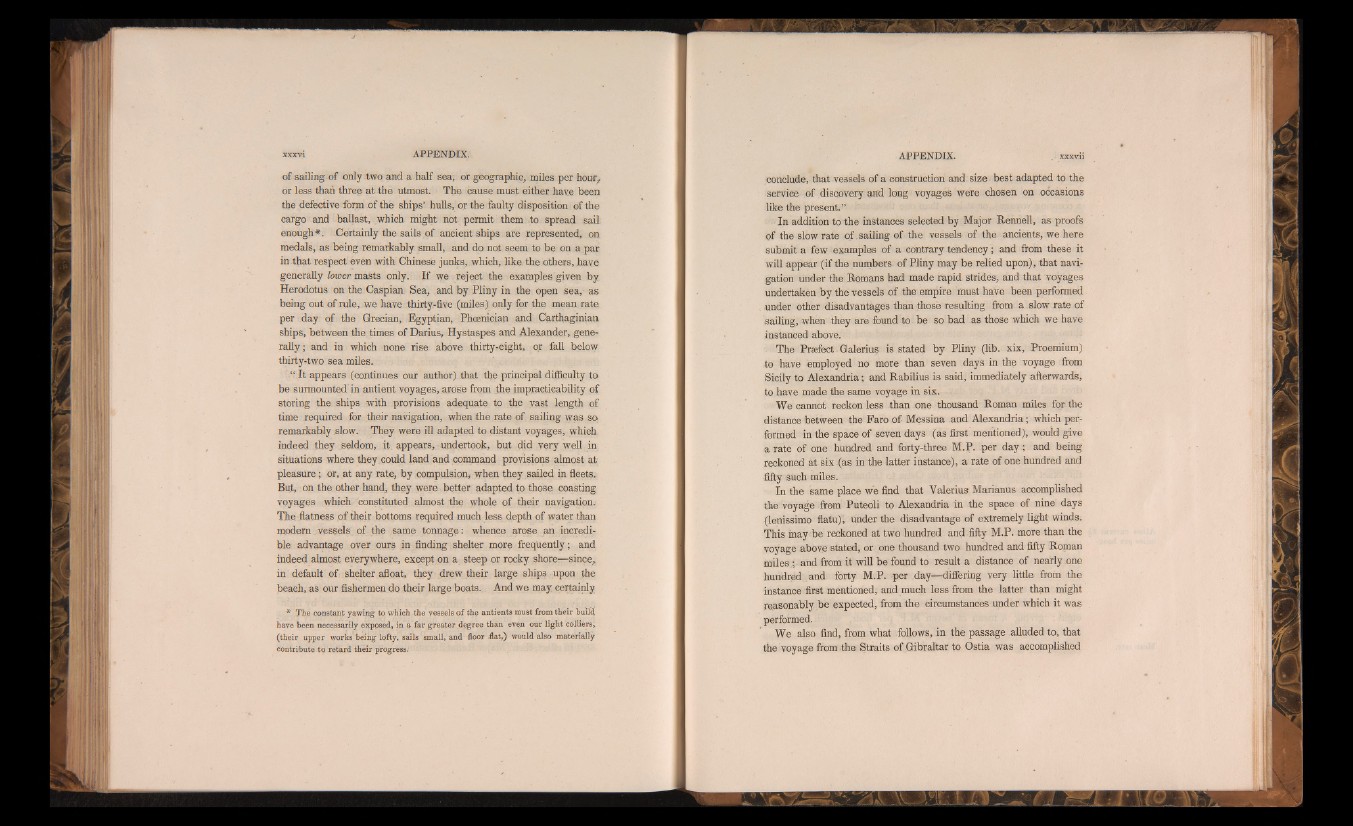
of sailing of only two and a half sea; or geographic, miles per hour,
or less than three at the utmost. The cause must either have been
the defective form of the ships’ hulls, o r the faulty disposition of the
cargo and ballast, which might not permit them to spread sail
enough*. Certainly the sails of ancient ships are represented, on
medals, as being remarkably small, and do not seem to be on a par
in that respect even with Chinese junks, which, like the others, have
generally lower masts only. I f we reject the examples given by
Herodotus on the Caspian Sea, and by Pliny in the open sea, as
being out of rule, we have thirty-five (miles) only for the mean rate
per day of the Grecian, Egyptian, Phoenician and Carthaginian
ships, between the times of Darius, Hystaspes and Alexander, generally
; and in which none rise above thirty-eight, or fall below
thirty-two se a miles.
“ I t appears (continues our author) that the principal difficulty to
be surmounted in antient voyages, arose from the impracticability of
storing the ships with provisions adequate to the vast length of
time required for their navigation, when the rate of sailing was so
remarkably slow. They were ill adapted to distant voyages, which
indeed they seldom, it appears, undertook, but did very well in
situations where they .could land and command provisions almost at
p le a su re ; or, at any rate, by compulsion, when they sailed in fleets.
But, on the other hand, they were better adapted to those coasting
voyages which constituted almost the whole of their navigation.
The flatness of their bottoms required much less depth of w ater than
modern vessels of the same tonnage « whence arose an incredible
advantage over ours in finding shelter more frequently;, and
indeed almost everywhere, except on a steep or rocky shore-—since,
in default o f shelter afloat, they ■ drew their large ships upon the
beach, as our fishermen do th e ir large boats. And we may certainly
* The constant yawing to which the vessels of the antients must from their buil((
have been necessarily exposed, in a far greater degree than even our light colliers,
(their upper works’ being lofty, sails small, and floor flat,) would also materially
contribute to retard their progress;
conclude, that vessels of a construction and size best adapted to the
service of discovery and long voyages were chosen on occasions
like the present." '
In addition to the instances selected by Major Rennell, as proofs
of the slow rate of , sailing of the vessels of the ancients, we here
submit a few examples of a contrary tendency; and from these it
will appear (if the numbers of Pliny may be relied upon), that navigation
under the Romans had made rapid strides, and that voyages
undertaken b y the vessels of the empire must have been performed
under other disadvantages than those resulting from a slow rate of
sailing, when they are found to be so bad as those which we have
instanced above.
The Prsefect Galerius is stated by Pliny (lib. xix, Proemium)
.to have employed no more than seven days in the voyage from
Sicily to Alexandria; and Rabilius is said, immediately afterwards,
to have made the same voyage in six.
We Gannot reckon less than one thousand Roman miles for the
distance between the Faro of Messina and Alexandria; which performed
in the space of seven days (as first mentioned), would give
a rate of one hundred and forty-three M.P. per day ; and being
reckoned at six (as in the latter instance), a rate of one hundred and
fifty such miles.
In the same place we find that Valerius Marianus accomplished
the voyage from Puteoli to Alexandria in the space of nine days
(lenissimo flatu), under the disadvantage of extremely light winds.
This may b e reckoned at two hundred and fifty M.P. more than the
voyage above stated, or one thousand two hundred and fifty Roman
miles ; and from it will be found to result a distance of nearly .one
hundred and forty M.P. per day—differing very little from the
instance first mentioned, and much less from the latter than might
reasonably b e expected, from the circumstances under which it was
performed.
We also find, from what follows, in the passage alluded to, that
the voyage from the Straits of Gibraltar to Ostia was accomplished